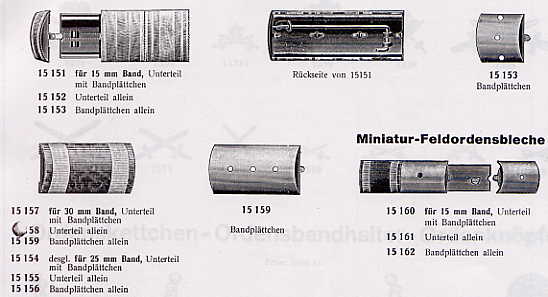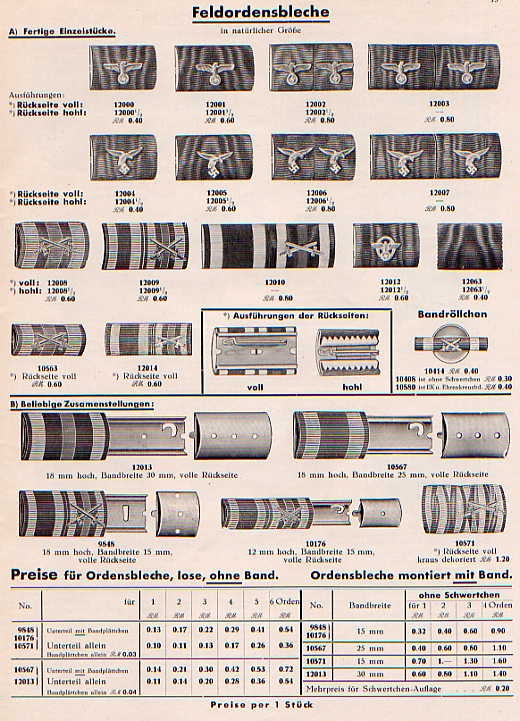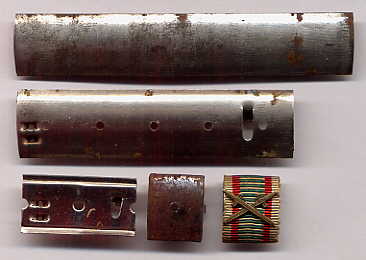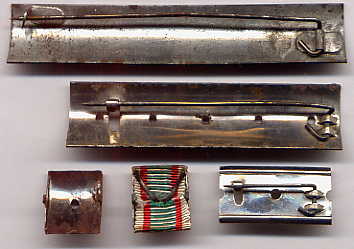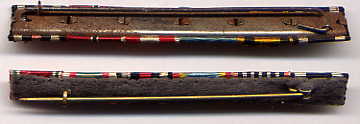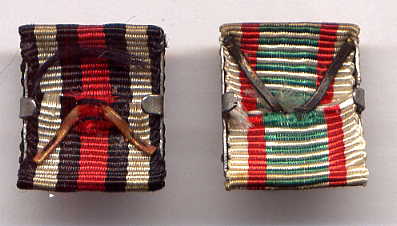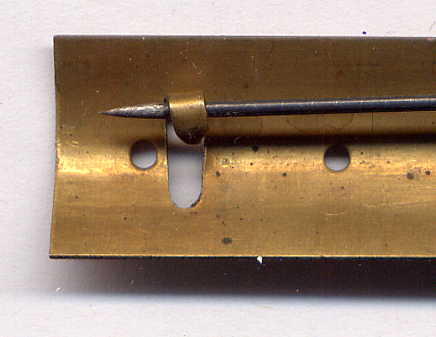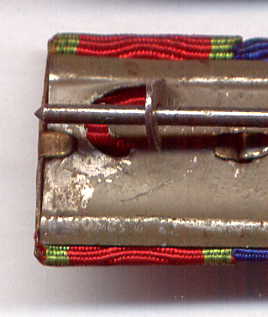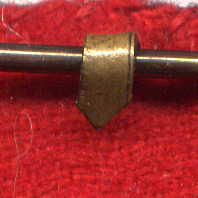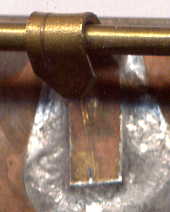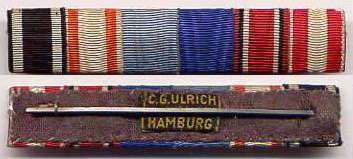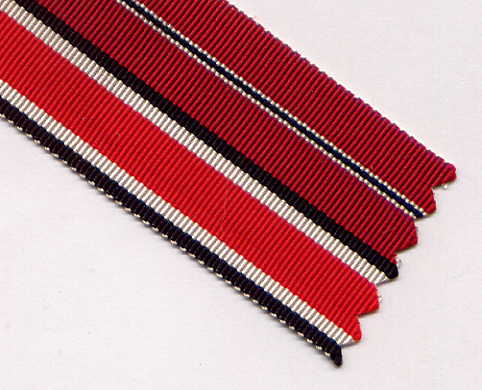
Content - Richard Lundström
Layout - Sebastian Bianchi
Construction of Real and Fake Ribbon Bars
|
|
This unfortunately anonymous salesman's catalog dated "Summer 1934" shows three types of the original M1915 nickled STEEL ribbon bar backings, still in use. Note that on this style, no device holes were punched through. The more modern tab-back style first introduced during the First World War was also available from the same supplier.
|
|
Note the pre-punched holes for secure and easy attachment of any devices. The other most typical varieties of ribbon bars are shown in this page from the January 1939 Steinhauer & Lück catalog.
|
|
Because ribbon bars in many combinations were individually made rather than stock items, wearers decided what version they wanted to buy, based on looks and price.
For the "scientific" purpose of this article, I have dissected several ordinary original ribbon bars to show what actual examples look like. (Now you don't have to!)
|
|
First the obverses: nickled steel M1915, nickled steel with pre-punched devices holes-the standard type from the late 1920s to 1945, and the nickled steel tab backed removable type.
Reverses: Note the usual corrosion of the steel through the surface finish.
|
|
Here are additional types of tab type backings;
|
|
The top is a variety with a copper colored finish over steel, rather than the usual nickled-both of these in the usual 15 mm width style. The last backing is for 25 mm width ribbons.
|
|
These two are the less common half height style: upper with removable tabs and lower sewn in with cloth covered backing. For some reason, ORIGINAL half height sewn bars like this-and half height ones ONLY-quite frequently have brass backings, even into WW2 period ribbon bars. Perhaps stamped steel with devices holes was not strong enough for such thin bars. Note the stamped catch hook.
|
|
One advantage to the tab back style, as far as retailers were concerned, was that they could easily mount ribbons simply by cutting lengths, pinning through the desired style device, and relying on the bent over devices prongs and the fit to the back plate to secure the ribbons-without need for hand labor that sewn together bars required.
|
|
This saw-toothed gripping edge style went back into the WWI period, but was one of the more unsatisfactory types, as the wear and tear along the very small edges of this circa 1940 ribbon bar shows.
|
|
The catch hooks that secured pinbacks fall into two main types. The upper bar shows the "tongue-shaped" or "U" style, punched directly through the metal backing plate. That was the virtually universal style from the 1930s on. The lower is a "C" style brass stamped catch, here soldered onto a steel back plate.
|
|
This "U" catch is on gold finished steel, not brass. Except for half height ribbon bars, brass was very rarely used as a backing material. Note the smooth, rounded bottom of the catch hooks when stamped out of the backing plates on "U" style bars.
|
|
Here is a brass "C" style catch hook close-up. The catch here IS brass, but is stamped and flat, perpendicular to the bar, soldered onto a plate. The reason for calling this style "C" is apparent from this Feldgrau backed WWI version, an integral stamping in the backing itself.
|
|
Integral stamped C's were weak and frequently broke. Soldered C's took too much labor time. By the 1930s, the "U" type was bar far the most common, though soldered C's can be found into WW2.
|
|
The contrast with the usual sort of FAKE ribbon bar pin catch is obvious. The thin sheet brass mock-"U" has been hand snipped (note the scoring line!)-and crudely cut off into a point, rather than correctly rounded. These snipped brass catches will bend easily with finger pressure. Another tip off on fake ribbon bars is the coarse, "loosely woven" cloth backing. With that covering removed, the sloppy workmanship of the ordinary long fake bar is revealed in splotchy lead solder and crude catch shape.
|
|
Mere sight of a hook like this is sufficient to condemn a ribbon bar as fake if you are unaware of what the ribbons and devices actually are. As word spread in the late 1990s of how easy these were to spot, the mass production forger began using white brass pins (normally crudely filed and quite sharp, not machined as well as original points were) and the sort of wire (thickness of the pins) hooks sometimes found on original catches. It was too little, too late. Even the forger's acquisition of a cache of unused original old metal backings in 2001 is not enough to make his frauds entirely fool proof: having exhausted many types of leftover original ribbon stocks on his early "all brass skeleton" fakes, he now has original backings-but is forced to resort to modern electric blue glowing fake ribbons. I have observed TWO ribbon bar fakes (absurd errors like a 1914 Iron Cross with 1941/2 East Medal-and no Hindenburg Cross!) on these original metal parts fakes, backed with a sort of "Brillo pad" colored coarse blackish gray wool. Having sunk to the level of piece work forgery of common, universally available double and triple ribbon bars, I can only restate: know the ribbons, know the regulations-and keep your blacklight at hand!
Returning to the happier subject of original ribbon bars, outfitter's labels are a nice find. They are much less common than on full sized medal bars.
|
|
This ribbon bar is a combination (Prussian Iron Cross 2nd Class, Red Eagle Order 4th Class, Crown Order 3rd Class, Reserve-Landwehr XX Years Service Cross, Red Cross Medal 3rd Class, and Hamburg Hanseatic Cross) that can be traced to char. Marine-Generaloberarzt Dr. med. Ernst Roediger (1857-1926), from circa 1917, and in "Reichs" precedence, placing all the Prussian awards including peacetime Orders and the long service cross ahead of the WWI award from Hamburg: a precedence interpretation more common in the Imperial navy than in the Prussian army.
 |
The prestigious Godet firm of Berlin seems to have preferred a tiny metal "license plate" tag for their WW1 period products. This is the reverse side of the ribbon bar seen here (in the overview section of this article). Most recipients seem to have pulled this potential snag off, since other "anonymous" Godet ribbon bars are readily identifiable from their uniquely bizarre Austro-Hungarian MMC "war decoration" wreath. Former Saxon Court Jeweler Scharffenburg of Dresden preferred to stamp their corporate information into the reverse of a tab backing plate, this from the 1930s.
|
|
A final note here should be made on the ribbons themselves. Until synthetics came into common use shortly before the outbreak of WW2, German ribbons were woven out of silk-occasionally in cotton. The transition to synthetics occurred in the mid 1930s, with old silk stocks tapering out in the early years of WW2. I have never seen any WW2 award's ribbon made out of anything but synthetics which NEVER glow electric blue on all white areas when a blacklight is shined on the bar. Other colors quite legitimately turn strange colors under a blacklight-vivid day glow orange from shades of red, etc. Only the vivid electric blue (the same intensity and shade produced by shining on modern computer printer/typing paper in the dark) is an absolute indication of a post 1960s fake. (Early Bundeswehr M1957 bars were still made out of ribbon synthetics that did not glow.) While it is possible to find WW2 ribbon bars with a mixture of old stock silk Imperial awards mixed in with newer Third Reich ribbons, of course nothing should ever be found in Imperial and 1920s bars but silk or cotton ribbons.
Common double and triple awards combinations were frequently woven together into single pieces from the 1930s into WW2. Much less hand work was required to assemble ribbon bars in the huge numbers required then by this simple expedient. Bars will often be found "mix and match" with multiples woven as one piece alongside single ribbons. Here is a length of 1939 Iron Cross 2nd Class and 1941/42 East Medal ribbons woven as one piece to speed assemble for the hundreds and hundreds of thousands of recipients of such common combinations.
|
|
The other most common WW2 one pieces were: War Merit Cross and East Medal, and Iron Cross 1939, War Merit Cross, East Medal. Taken together, these probably equally their 1930s forerunner, the combined 1914 Iron Cross and Hindenburg Cross. Other combinations like a long service ribbon and Sudeten Medal also existed.
![]()
© Copyright Wehrmacht-Awards.com LLC |

